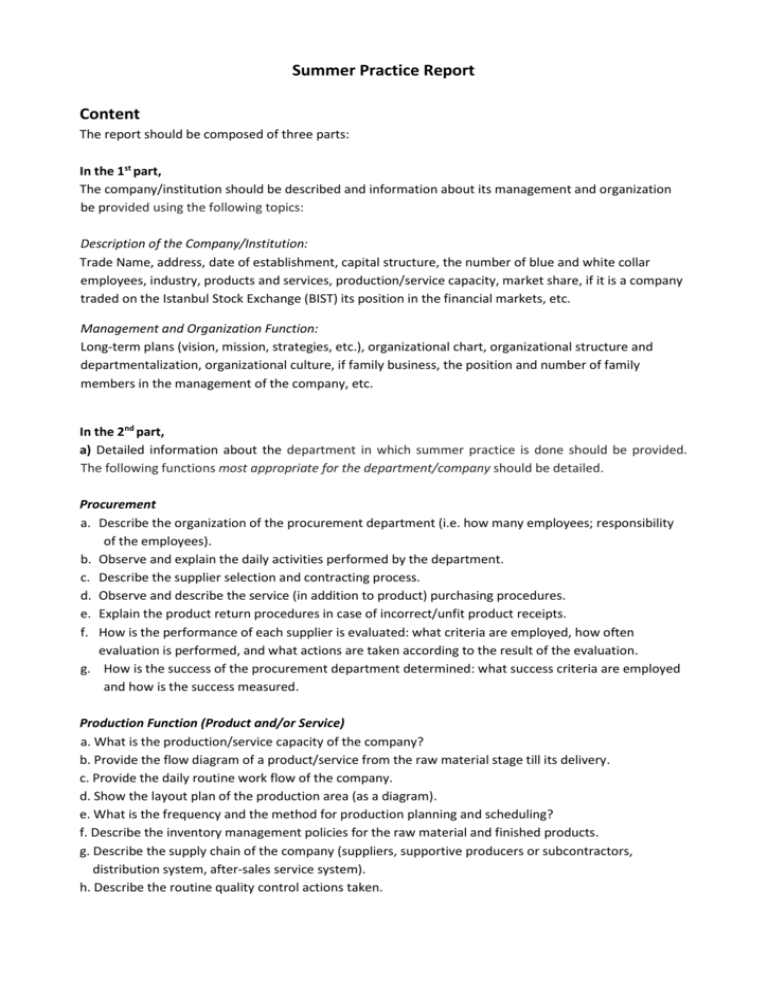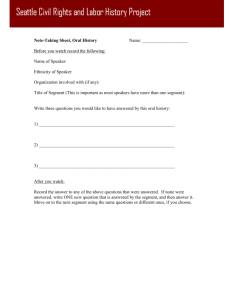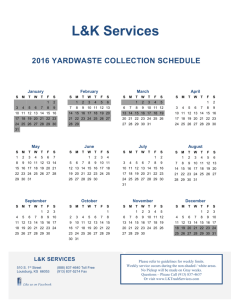Summer Practice Report
advertisement

Summer Practice Report Content The report should be composed of three parts: In the 1st part, The company/institution should be described and information about its management and organization be provided using the following topics: Description of the Company/Institution: Trade Name, address, date of establishment, capital structure, the number of blue and white collar employees, industry, products and services, production/service capacity, market share, if it is a company traded on the Istanbul Stock Exchange (BIST) its position in the financial markets, etc. Management and Organization Function: Long-term plans (vision, mission, strategies, etc.), organizational chart, organizational structure and departmentalization, organizational culture, if family business, the position and number of family members in the management of the company, etc. In the 2nd part, a) Detailed information about the department in which summer practice is done should be provided. The following functions most appropriate for the department/company should be detailed. Procurement a. Describe the organization of the procurement department (i.e. how many employees; responsibility of the employees). b. Observe and explain the daily activities performed by the department. c. Describe the supplier selection and contracting process. d. Observe and describe the service (in addition to product) purchasing procedures. e. Explain the product return procedures in case of incorrect/unfit product receipts. f. How is the performance of each supplier is evaluated: what criteria are employed, how often evaluation is performed, and what actions are taken according to the result of the evaluation. g. How is the success of the procurement department determined: what success criteria are employed and how is the success measured. Production Function (Product and/or Service) a. What is the production/service capacity of the company? b. Provide the flow diagram of a product/service from the raw material stage till its delivery. c. Provide the daily routine work flow of the company. d. Show the layout plan of the production area (as a diagram). e. What is the frequency and the method for production planning and scheduling? f. Describe the inventory management policies for the raw material and finished products. g. Describe the supply chain of the company (suppliers, supportive producers or subcontractors, distribution system, after-sales service system). h. Describe the routine quality control actions taken. Accounting and Finance Function of A Business Entity a. Describe the organization of the accounting and finance department (i.e. how many employees; responsibility of the employees). b. Observe and explain the daily activities performed by the department. c. Learn about the periodic management reports prepared by the department. What kinds of reports are prepared? When and for whom such reports are presented? Who prepares the reports? d. Identify and summarize the internal control weaknesses and strengths of the organization. e. If you are provided with the information, conduct a financial analysis of the company. Accounting and Auditing Firm a. Provide a list of major clients of the firm. b. Learn how frequently the clients are subject to an audit and why. c. Describe the responsibilities of a typical audit team (i.e. the role of the partner; manager etc…) d. If you are assigned to a client describe your responsibilities. If you are assigned to more than one client, then repeat this task for each of them. e. Briefly comment on the aspects of an auditing career that you most liked and disliked. Banks a. Provide a list of major financial products offered by the bank. b. What are the strengths of the bank branch that you are working in terms of the products? c. What are the financial benchmarks the branch assessed towards? d. How does the bank decide to give a credit to an individual? e. How does the bank decide to give a credit to a firm? Marketing Function a. Describe major segments the company targets. Provide a profile (customer characteristics) information about each segment. b. Identify the positioning strategy the company employs in each segment. How does the company differentiates it’s offerings from the competitors in each segment. c. Provide detailed information about the 4Ps the company uses in each segment. In other words, for each segment, explain the product, price, place and promotion activities of the company separately. d. Explain, with specific examples, how marketing research is utilized in decision making. e. Explain, with examples, what retention and loyalty activities the company carries out. f. How is the success of the marketing department determined: what success criteria are employed and how is the success measured. Sales Function (Note: make sure to provide specific examples in responding the following items) a. Describe prospecting and sales call planning activities. b. Describe critical components of the company’s sales presentations. c. Describe common negotiation techniques sales people use and explain, how salespeople respond to customer concerns during negotiations? d. Describe common sales closing techniques. e. Describe company’s policies and procedures for recruitment, training, performance evaluation, and compensation of the sales force. f. Describe company’s code of sales ethics and comment on the company’s commitment to ethical business practices. Human Resources Function a. Describe the selection and placement policies. b. Describe the training and development programs. c. What kind of motivational tools are employed? d. How is career planning conducted? e. Describe and discuss the effectiveness of the performance evaluation system used (e.g., criteria used for measuring performance at the individual, departmental, and organizational levels, who evaluates whom, etc.) f. If you are provided with the information, describe the compensation and benefits provided to employees and managers at different levels. How are they linked to performance evaluation system? b) Responsibilities and duties granted and undertaken in the department should be explained. In this respect, students’ are expected to keep notes about their roles, responsibilities, and observations on a weekly basis. These weekly notes should be presented in the annexes of the report. An example of weekly notes can be obtained from our web site. In the 3rd part, In parallel with the Student Evaluation Form, the evaluation of the summer practice experience should be provided where both positive and negative aspects of the internship are mentioned. In this respect, the contributions of the summer practice in terms of issues such as application of business knowledge and skills, computer, teamwork, written and oral communication skills, usage of new tools and technologies, data gathering, analysis, and interpretation should be evaluated. Contributions of the student to the department or organization as well as his/her suggestions should also be explained in this part. Format The report should be written in compliance with the written communication evaluation rubric (can be found on the next page) and specifically by adhering to the following standards: The report should have a cover sheet (student's name, company name, training dates, etc.). The report should be at least 2000 words. Times New Roman, 12 pt., with 1.5 line spacing should be used. The margins should be 2.5 cm in from each side. If there are references, they should be provided at the end of the report. Attachments (weekly notes, any information cited in the report such as company statistics, tables, diagrams, etc.) should be placed at the end of the report. The report should be written scientifically and by paying attention to grammar, spelling, and punctuation rules and with an understandable language. Written communication evaluation rubric Content and task fulfillment (critical issues and questions to be supplied by the guidelines) 1. Document states the purpose 2. Document fulfills the content expectations specified by the guidelines (i.e., description of the issue, background information, key considerations, ending, etc.) Clarity and justification 3. Writing is precise/to the point 4. Document sustains reader’s attention 5. Ideas are logically developed and justified 6. Sentences and paragraphs are logically organized and connected Format 7. Document adheres to an appropriate format (specified by the guidelines) 8. Document is accurately and professionally formatted specified by the guidelines (i.e. adequate spacing between paragraphs, spacing, indentation and margins) Written business language proficiency 9. Document uses a range of advanced level formal vocabulary accurately 10. Document uses business jargon/terminology 11. Document is free from grammatical errors 12. Language is audience appropriate Information display (if applicable as requested by the guidelines) 13. The information is displayed adequately with appropriate techniques (e.g., graphs, tables, figures) 14. Information is presented clearly (e.g., clear titles, labels, appropriate values, notations) 15. Displays are connected with the relevant ideas in the body of the document








